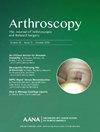Editorial Commentary: Knee Posterolateral Corner Reconstruction Shows Low Failure and Complication Rates
IF 4.4
1区 医学
Q1 ORTHOPEDICS
Arthroscopy-The Journal of Arthroscopic and Related Surgery
Pub Date : 2024-09-11
DOI:10.1016/j.arthro.2024.09.010
引用次数: 0
Abstract
High-grade knee posterolateral corner (PLC) injuries are potentially devastating and often associated with high-energy mechanisms. Failure of PLC injury diagnosis or treatment can lead to residual instability after combined cruciate ligament reconstruction because of the increased risk of graft failure, and varus malalignment may lead to early osteoarthritis and meniscal injuries. PLC reconstruction has consistently shown superiority over PLC repair. Biomechanical studies have compared reconstruction techniques, specifically evaluating rotational and varus laxity. Some studies have demonstrated no difference between techniques, whereas other studies have reported improved stability with techniques that include a separate tibial tunnel for reconstruction of the popliteus tendon and popliteofibular ligament. Yet many have suggested that there is less technical difficulty with techniques that do not use a tibial tunnel, and this may be an important consideration in certain settings. Recent reviews showing no differences in clinical outcomes when comparing techniques for PLC reconstruction are based on heterogeneous, low level of evidence, high-risk-of-bias literature. It is well recognized that PLC injuries are heterogeneous, with approximately three quarters occurring in combination with anterior and/or posterior cruciate ligament tears. Further, laxity patterns vary for these injuries including high-grade posterior laxity and knee hyperextension as well as proximal tibial-fibular joint laxity, and these findings may necessitate use of an anatomic (separate tibial tunnel) PLC reconstruction technique. Reassuringly, both techniques show low complication and failure rates.
膝关节后外侧角重建失败率和并发症发生率较低
高级膝关节后外侧角(PLC)损伤具有潜在的破坏性,通常与高能量机制有关。PLC损伤的诊断或治疗失败可能导致联合十字韧带重建术后的残余不稳定性,因为移植失败的风险增加,而曲张错位可能导致早期骨关节炎和半月板损伤。PLC重建一直显示优于PLC修复。生物力学研究对重建技术进行了比较,特别是对旋转和屈曲松弛进行了评估。一些研究表明重建技术之间并无差异,而另一些研究则报告称,重建腘绳肌腱和腘绳肌腱的技术包括一个独立的胫骨隧道,可提高稳定性。然而,许多人认为不使用胫骨隧道的技术难度较低,这在某些情况下可能是一个重要的考虑因素。最近的一些综述显示,在比较 PLC 重建技术时,临床结果没有差异,这些综述是基于异质性、低证据水平、高偏倚风险的文献。众所周知,PLC 损伤具有异质性,约四分之三的损伤同时伴有前交叉韧带和/或后交叉韧带撕裂。此外,这些损伤的松弛模式也不尽相同,包括高度后方松弛、膝关节过伸以及胫腓关节近端松弛,这些发现可能需要使用解剖型(独立胫骨隧道)PLC 重建技术。令人欣慰的是,这两种技术的并发症和失败率都很低。
本文章由计算机程序翻译,如有差异,请以英文原文为准。
求助全文
约1分钟内获得全文
求助全文
来源期刊
CiteScore
9.30
自引率
17.00%
发文量
555
审稿时长
58 days
期刊介绍:
Nowhere is minimally invasive surgery explained better than in Arthroscopy, the leading peer-reviewed journal in the field. Every issue enables you to put into perspective the usefulness of the various emerging arthroscopic techniques. The advantages and disadvantages of these methods -- along with their applications in various situations -- are discussed in relation to their efficiency, efficacy and cost benefit. As a special incentive, paid subscribers also receive access to the journal expanded website.

 求助内容:
求助内容: 应助结果提醒方式:
应助结果提醒方式:


